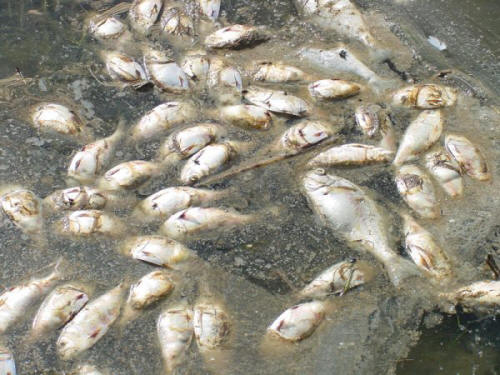
 |
Dead zonesare areas where the bottom water (the water at the sea floor) is anoxic ó meaning that it has very low (or completely zero) concentrations of dissolved oxygen. These dead zones are occurring in many areas along the coasts of major continents, and they are spreading over larger areas of the sea floor. Because very few organisms can tolerate the lack of oxygen in these areas, they can destroy the habitat in which numerous organisms make their home. (reference)
|
The cause of anoxic bottom waters is fairly simple: the organic matter produced by phytoplankton at the surface of the ocean (in the euphotic zone) sinks to the bottom (the benthic zone),where it is subject to breakdown by the action of bacteria, a process known as bacterial respiration. The problem is, while phytoplankton use carbon dioxide and produce oxygen during photosynthesis, bacteria use oxygen and give off carbon dioxide during respiration. The oxygen used by bacteria is the oxygen dissolved in the water, and thatís the same oxygen that all of the other oxygen-respiring animals on the bottom (crabs, clams, shrimp, and a host of mud-loving creatures) and swimming in the water (zooplankton, fish) require for life to continue. Marine bacteria feed on the algae in the blooms after it has died and sunk to the bottom, and in doing so they use up all of the oxygen dissolved in the water. The resulting 'hypoxic' seabed zones can asphyxiate swathes of bottom dwelling organisms such as clams and worms, and disrupt fish populations. |
 |
The Baltic Sea, site of the world's largest dead zone, has lost about 30% of its available food energy, which has led to a significant decline in its fisheries. The lack of oxygen can also force fish into warmer waters closer to the surface, perhaps making them more susceptible to disease. The size of marine dead zones often fluctuates with the seasons. A massive dead zone, some 21,000 square kmacross, forms each summer in the Gulf of Mexicoas floodwater flushes nitrogen-rich fertiliser into the Mississippi River. Climate change could be adding to the problem. Many regions are expected to experience more severe periods of heavy rain, which could wash more nutrients from farmland into rivers. (reference)
You want to share some ideas, or data with the visitors of the Corrosion Doctors Web site please send a note to our